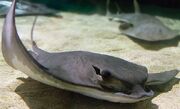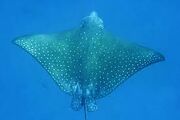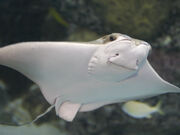Tag: Visual edit |
Tag: Visual edit |
||
| Line 11: | Line 11: | ||
== Closest Relatives == |
== Closest Relatives == |
||
| − | Rhinopristiformes |
+ | Rhinopristiformes |
== Example Species in Chimaeriformes == |
== Example Species in Chimaeriformes == |
||
| Line 40: | Line 40: | ||
[[File:Cownose ray.jpg|thumb|'''ref:''' https://audubonnatureinstitute.org/aquarium/cownose-ray]] |
[[File:Cownose ray.jpg|thumb|'''ref:''' https://audubonnatureinstitute.org/aquarium/cownose-ray]] |
||
| − | ===''Rhinoptera bonasus''=== |
+ | ====''Rhinoptera bonasus''==== |
Defining Features:The cownose ray has a dark to golden brown coloring on the top with a white underside. The ray has a long whiplike tail with two mildly venomous spines. They get their name from its squared, indented snout that resembles a cow nose. The ray has winglike pectoral fins. Cownose rays migrate long distances in large schools. |
Defining Features:The cownose ray has a dark to golden brown coloring on the top with a white underside. The ray has a long whiplike tail with two mildly venomous spines. They get their name from its squared, indented snout that resembles a cow nose. The ray has winglike pectoral fins. Cownose rays migrate long distances in large schools. |
||
Revision as of 03:13, 11 August 2020
Defining Features
Myliobatiformes are more commonly known as stingrays. Typical members of Myliobatiformes are characterized as having a strongly depressed disc, that is rhomboid, oval, or triangular in shape. Myliobatiformes can have stout or long and whiplike tails, some Myliobatiformes have venomous spines or barbs on the tail. Myliobatiformes have enlarged pectoral fins that are fused to the forehead or rostrum, and 5 gill slits located on the ventral or belly side of the ray.
Habitat and Range
Myliobatiformes live in tropical and subtropical zones of the Atlantic, Pacific, and Indian oceans. Most Myliobatiformes are bottom feeders who live on, but some are pelagic. Most stingray live in coastal waters, but some live in deep ocean.
Fisheries Conservation and Concern
Different species of stingrays range in status from having healthy populations to being listed as vulnerable. Stingrays are commercially fished and sought after for their meat in many parts of the world particularly outside of the United States. They are also common by-catch on fishing vessels.
Closest Relatives
Rhinopristiformes
Example Species in Chimaeriformes
Bat Ray
Myliobatis californica

Reference: http://www.aquariumofpacific.org/onlinelearningcenter/species/bat_ray
Defining Features: The bat ray is a large ray weighing up to 200 pounds with a width of 6 feet. Their long pectoral fins are pointed and resemble bat wings. They have a large venomous barb attached to a long whiplike tale. Their head protrudes more than the majority of rays and they have rather large eyes. Their coloration is dark brown or black in color with a white underbelly.
Range & Habitat: Bat rays habitat ranges from Oregon to the Gulf of California and also the Galapagos Islands. They primarily live in shallow, sandy or muddy areas as well as kelp forests. They can be found at depths of 1-46 meters.
IUCN Concern: Least Concern
Spotted Eagle Ray
Aetobatus Narinari

Reference: https://fishesofaustralia.net.au/home/species/2034
Defining Features: Spotted Eagle Rays are massive with a maximum width of almost 10 feet and maximum published weight of 507 pounds. They have a pointed v-shaped snout concealing platelike teeth that they use to crush shellfish. They have extremely long tails with venomous barbs attached to them. One of their more distinct features is their coloration which is either black, brown, or grey with white rings or dots.
Range & Habitat: Spotted Eagle rays are found in warm coastal water all over the world. They are usually found in depths of around 200 feet where they swim in schools in the open water.
IUCN Concern: They are near threatened and their population is decreasing.
Example Species in the Gulf of Maine
Cownose Ray

ref: https://audubonnatureinstitute.org/aquarium/cownose-ray
Rhinoptera bonasus
Defining Features:The cownose ray has a dark to golden brown coloring on the top with a white underside. The ray has a long whiplike tail with two mildly venomous spines. They get their name from its squared, indented snout that resembles a cow nose. The ray has winglike pectoral fins. Cownose rays migrate long distances in large schools.
Range & Habitat: Cownose rays prefer to live in shallow brackish waters, and like to swim at the surface but they can be found at depths of 72 feet. The cownose ray appears in the Eastern and Western parts of the Atlantic ocean. In the Western Atlantic Ocean they can be found from New England to Florida, and throughout the Gulf of Mexico, Trinidad, Venezuela, and Brazil.
IUCN Concern: The cownose ray is classified as Nearly Threatened. They're inshore habitat and schooling behavior can lead to them being impacted by heavy fishing pressure.
References
https://www.fishbase.in/summary/OrdersSummary.php?order=Myliobatiformes
http://www.elasmo-research.org/education/shark_profiles/myliobatiformes.htm
https://www.floridamuseum.ufl.edu/discover-fish/species-profiles/rhinoptera-bonasus/
https://sharksrays.org/
https://www.iucnredlist.org/species/60128/12310195#habitat-ecology